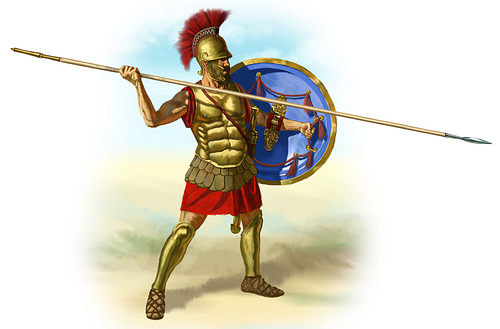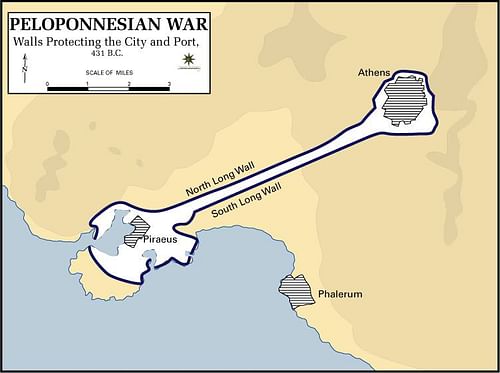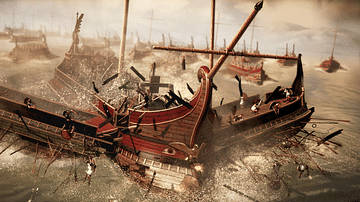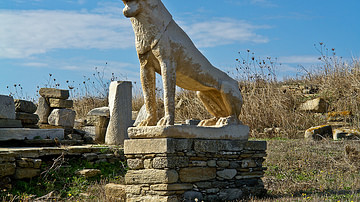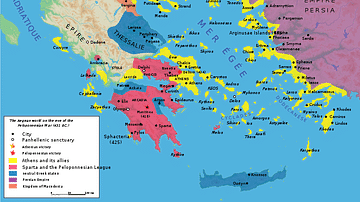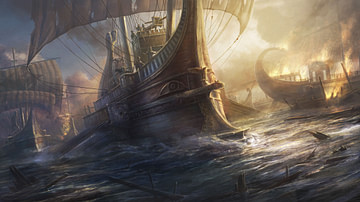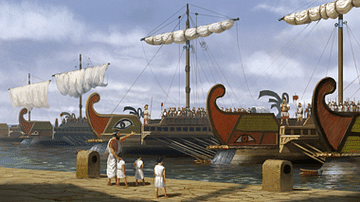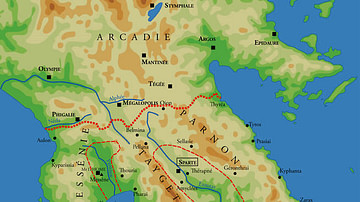![Greek Trireme [Artist's Impression] (by The Creative Assembly, Copyright) Greek Trireme [Artist's Impression] (by The Creative Assembly, Copyright)](https://www.worldhistory.org/img/r/p/500x600/4650.jpg?v=1710090064)
The Peloponnesian War between Athens and Sparta and their respective allies came in two stages: from c. 460 to 446 and from 431 to 404 BCE. With battles at home and abroad, the long and complex conflict was damaging to both sides. Sparta, with financial help from Persia, finally won the conflict by destroying the Athenian fleet at Aegospotami in 405 BCE.
Causes of the War
In the 5th century BCE Sparta and Athens were the two major powers in Greece and it was perhaps inevitable that their spheres of influence would overlap and cause conflict. Sparta seems to have been particularly alarmed at the growing power of Athens, able to build an ever-bigger fleet of ships thanks to tributes from its allies and dependants. Sparta was also suspicious of the Athenians' project to rebuild their Long Wall fortifications which protected their harbour of Piraeus. In addition, Sparta was also concerned that inaction would push the other major Greek power, Corinth, to side with Athens.
What has become known as The First Peloponnesian War (c. 460-446 BCE) was less intense than the second and fought mainly between Athens and Corinth with occasional intervention by Sparta. The war was followed by the Thirty Year's Peace although in reality hostilities never fully ceased and broke out into full war once again from 431 BCE.
A flashpoint in Spartan-Athenian relations was Poteidaia in 432 BCE. Athens wanted timber and minerals from Thrace and so demanded Poteidaia remove their fortifications. The Poteidaian's asked for Sparta's protection and received a promise of assistance. Athens went ahead and laid siege to the city anyway, shortly after, also issuing the Megarian Decrees. These prevented Megara from using any port of Athens or her allies, effectively imposing a trade embargo. Sparta, a long-time ally of Megara, asked Athens to repeal the decree as it would make Megara wholly dependent on Athens. The Athenians, cajoled by Pericles, refused but the Spartans withheld from formally declaring war, perhaps due to their state of unreadiness for another long conflict. In fact, though, hostilities broke out elsewhere when Thebes attacked Plataea, an ally of Athens, and in 431 BCE the Peloponnesian army led by the Spartan king Archidamos invaded and ravaged Attica. The War was back on again.
Warfare in the Second Peloponnesian War became more sophisticated and more deadly with the conventions of warfare breaking down and resulting in atrocities previously unthinkable in Greek warfare. Civilians became much more involved in warfare and entire citizen bodies could be wiped out as happened at Mykalessos in Boeotia. The number of casualties in the wars was, therefore, far greater than in any previous conflict in Greece's long history.
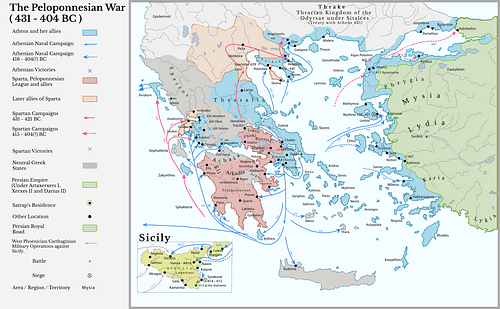
Athens & Her Allies
Following the Persian Wars of the early 5th century BCE the Greek city-states or poleis began to align themselves in protective alliances. Many states sided with Athens, notably those from Ionia, and together they formed the Delian League sometime around 478 BCE. The League, at its greatest size was composed of over 300 members who paid tribute to Athens, the strongest naval power in Greece, in the form of either ships or money in return for Athenian protection against a perceived threat from Persian and perhaps also Mediterranean pirates. The treasury of the League was placed on the sacred island of Delos in the Cyclades.
Starting with the repression of Naxos, however, the League swiftly came to resemble an Athenian empire rather than a collection of equal allies, a process confirmed by the moving of the treasury to Athens in 454 BCE. Whatever the politics, the practical consequences of the League was that Athens' navy could strike anywhere, especially after rival sea-power Aegina was taken, and it caused significant supply problems to several cities throughout the war, notably Corinth.
Sparta & Her Allies
The tough military training in Sparta, which started from the age of seven and was known as the agōgē, resulted in a professional hoplite army capable of great discipline and relatively sophisticated battle manoeuvres which made them feared throughout Greece, a fact perhaps evidenced by Sparta's notable lack of fortifications for most of its history.
The regional instability in Greece in the late 6th century BCE brought about the Peloponnesian League (c. 505 to 365 BCE) which was a grouping of Corinth, Elis, Tegea and other states (but never Argos) where each member swore to have the same enemies and allies as Sparta. Membership of the League did not necessitate the paying of tribute to Sparta but rather the provision of troops under Spartan command. The League would allow Sparta to establish hegemony over and dominate the Peloponnese until the 4th century BCE.
![Greek Hoplites [Artist's Impression]](https://www.worldhistory.org/img/r/p/500x600/4820.png?v=1653899588)
Innovations in Warfare
Like all great conflicts, the Peloponnesian War brought about changes and developments in warfare. The heavily armed hoplite in the phalanx formation (lines of closely packed hoplites protecting each other with their shields) still dominated the Greek battlefield but the phalanx did become deeper (more rows of men) and wider (a longer front of men) during the Peloponnesian War. The dominance of the hoplite on the battlefield was also threatened by the deployment of combined arms using mixed troops - hoplites, light infantry and cavalry - a tactic which became ever more widespread.
Other developments in warfare included an increase in the use of slaves, mercenaries and foreigners in Greek armies, better logistics which allowed armies to stay longer in the field, and a greater attention paid to skills and experience when selecting military leaders. Weapons generally did not develop in respect to earlier conflicts although there were exceptions such as the primitive flame throwers which were used against the wooden fortifications of Delon in 424 BCE.
Sparta's Invasions of Attica
With one side predominantly a land-based army and the other a great maritime power it is not perhaps surprising that the war dragged on for decades with indecisive victories and ineffectual raids. The principal Spartan strategy was to annually attack Athenian lands, starting in 431 BCE, creating as much destruction as possible such as burning farms, chopping down olive trees and vineyards. However, the actual effect of this on the Athenian economy is unclear, especially when considering that the city could always be resupplied by sea via the city's port of Piraeus protected by the Long Walls. It may have been a Spartan strategy to entice the Athenians out from behind their fortifications into open battle, a temptation that Athens, and particularly Pericles, always resisted. Athens could also and did retaliate by landing troops by sea into Spartan territory and inflict similar damage.
Athens was hit by a devastating plague (arriving from Egypt via Persia) in 430 BCE and Sparta even postponed her annual invasion to avoid it. In the same year Pericles was ousted and Athens sued for peace only to be rejected by Sparta. However, under Kleon and Nikias, the Athenians enjoyed a successful campaign in the Corinthian Gulf in 429 BCE and hopes for an early Spartan victory now seemed hopelessly ambitious.
Sieges
Sieges were another common feature of the Peloponnesian War. They were already a feature of Greek warfare but they increased dramatically in number during the Peloponnesian Wars, reaching around 100, 58 of which were successful (for the attackers). Siegecraft involved two main strategies - repeatedly attacking the city directly (until the defenders capitulated or the walls were breached) and circumvallation or surrounding the city with a wall (and starving the city into surrender). In the latter strategy there was also the hope that betrayal and in-fighting might also compromise the defenders. The second strategy was much more costly and time-consuming as it often took years to achieve success. If a city did finally fall then death or slavery was the usual result for the defeated.
The next action in the war was the siege of Plataea between c. 429-427 BCE which had elements of both siege strategies. First, the Peloponnesian forces used more aggressive tactics by blockading the town with a wooden palisade and building an earth ramp to compromise the walls. However, the Plataeans responded to this threat by building even higher walls. The Peloponnesians then used battering rams (embole) against the walls but the defenders once again thwarted the attackers by dropping large beams on chains to break the rams. The attackers then decided to dig in for a long siege and play the waiting game, a strategy that was ultimately successful as they starved the Plataeans into surrendering but only after two years.
The War Rumbles On
In 428 BCE Athens ruthlessly crushed a revolt on Lesbos involving Mytilene and in 427 the fall of Plataea was followed by a civil war on Kerkyra (Corfu) and a failed Athenian attempt to support Leontinoi in Sicily. In 426 BCE Demosthenes led 40 triremes in a campaign against Pylos (they were in fact on their way to Sicily) where they defeated the Spartans occupying Sphakteria. In 424 BCE the Athenians launched an expedition against Megara and Boeotia but this was another failure and involved a heavy defeat near Delion. Athens did, however, take the Spartan island of Kythera. The Spartans too had successes, now commanded by Brasidas and using non-Spartan hoplites for the first time, they captured several poleis in Attica, notably Amphipolis - although both Kleon and Brasidas were killed in the battle.
In 423/421 BCE a truce was called and a 50 year peace was agreed. There were some territorial concessions on both sides but principally the situation returned to the pre-war status quo. However, individual commanders in the field refused to hand over cities and an alliance was formed between Mantineia, Argos, Elis, Corinth and the Chalkidians. In 420 BCE Sparta formed an alliance with Boeotia. Also in 420 BCE the new Athenian leader Alcibiades brokered an alliance between Athens, Argos, Elis and Mantineia. It looked very much like both sides were manoeuvring for a re-start.
In 418 BCE there was the major battle at Mantineia where Sparta, led by Agis II, defeated Argos and her allies. The war now took on a more brutal aspect with Sparta killing all the citizens of Hysiai (417/16 BCE) and Athens, in the same period, executing the citizens of Melos.
The Sicilian Expedition
In 415 BCE Athenian general Alcibiades was the mastermind behind the invasion of Sicily, the largest operation of the entire war. Athens wanted Sicilian timber for her fleet and the pretext for the attack was a request for help from the small polis of Segesta which sought protection from Syracuse. However, on the eve of departure Alcibiades was implicated in serious accusations of impiety and was stripped of command. Not wishing to face what he felt would be a biased trial, Alcibiades fled to Sparta. The military operation continued under Nikias but was a complete disaster, an ineffectual siege was broken by a Spartan army led by Glypus, the Athenian fleet was routed in the harbour of Syracuse and both Nikias and Demosthenes were executed in 413 BCE.
Aegospotami & Victory
Athens was not beaten yet though and she continued to raid the Peloponnese from the sea. Sparta, following the advice of Alcibiades, built a fort at Dekeleia to more easily disrupt Attic agriculture with their annual attacks on Attic farmland. Agis made his headquarters at Dekeleia and received envoys from various poleis wishing to leave the Delian League, notably Chios and Miletos. Persia also made overtures to Sparta, offering money with which to build a fleet that could challenge Athens in return for Sparta recognising Persian sovereignty in Asia Minor.
The War was finally won by Sparta, then, and perhaps ironically, in a naval battle. After a long series of naval defeats to the Athenians and even an unsuccessful sue for peace after the naval defeat to Alcibiades at Kyzikos in 410 BCE, Sparta was able to build a massive fleet of 200 triremes using Persian money and timber. With this formidable weapon, Lysander was able to inflict a final and total defeat on the Athenians at Aegospotami near the Hellespont in 405 BCE where 170 Athenian ships were captured on the beach and at least 3,000 Athenian captives were executed. Now unable to man another fleet, with the Delian League disbanded and Athens itself under siege, the Athenians had no option but to sue for peace. Conditions of surrender were the dismantling of the Long Walls, the prohibition of rebuilding a fleet bigger than 12 ships and the payment of tribute to Sparta, which was now, finally, recognised by all as the dominant power in Greece.
Aftermath
Sparta's position as the number one city-state in Greece, though, was to be short-lived. Continued Spartan ambitions in central and northern Greece, Asia Minor and Sicily once again dragged the city into another protracted conflict, the Corinthian Wars with Athens, Thebes, Corinth and Persia from 396 to 387 BCE. The result of the conflict was the 'King's Peace' where Sparta ceded her empire to Persian control but Sparta was left to dominate Greece. However, trying to crush Thebes, Sparta lost the crucial battle of Leuctra in 371 BCE against the brilliant Theban general Epaminondas. Perhaps the real winner of the Peloponnesian Wars was actually, then, Persia and in the long term even Macedonia which under Philip II was able to invade and crush with relative ease the weakened and mutually suspicious Greek city-states.
